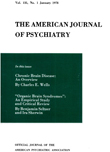VERIFICATION OF THE RORSCHACH ALPHA DIAGNOSTIC FORMULA FOR UNDERACTIVE SCHIZOPHRENICS
Abstract
1. The 1950 perceptanalytic alpha formula designed to aid in the differentiation between psychosis and neurosis(8) was tested on a new group of 145 patients, 100 schizophrenics, and 45 neurotics. All patients were followed for at least 3 years and were rediagnosed by Nolan D. C. Lewis. Their condition at the end of the 3-year period subsequent to the original Rorschach examination was evaluated in terms of improved, essentially unchanged, and worse.
2. An alpha formula score of 3 points or more indicates a mental condition more serious than a mere psychoneurosis, i. e., a schizophrenia, a manic-depressive psychosis, or intracranial pathology. If the alpha score is less than 3 points, a diagnosis of psychoneurosis indicated. The 1950 formula (Table 2) agreed with the independently made clinical psychiatric follow-up diagnoses in 83% of the 145 cases. The formula was as accurate in the diagnosis of schizophrenia as of neurosis provided both technical Rorschach requirements were met: ∑c≥∑C and W 7. If only one requirement was met, high alpha scores retained their validity but low scores were not valid. The validity of the formula in its present stage may depend upon the patient's intelligence; an IQ of at least 100 may be a necessary condition.
3. The formula grew out of the theoretical assumption (1) that in neurotics potential energy output is proportionate to their energy control in psychosocial situations, i. e., in the social interactions between the individual and others; and ( 2) that in cases more serious than a mere neurosis there is a disproportion between the patient's energy control and his potential energy output in social interactions. High alpha scores are not incompatible with the presence of neurotic symptoms. Schizophrenics as well as organic cerebral cases may have neurotic difficulties in addition to personality weaknesses specifically contingent upon schizophrenia or intracranial pathology.
4. The alpha formula may be the beginning of one of several possible laboratory tests for schizophrenia.
Access content
To read the fulltext, please use one of the options below to sign in or purchase access.- Personal login
- Institutional Login
- Sign in via OpenAthens
- Register for access
-
Please login/register if you wish to pair your device and check access availability.
Not a subscriber?
PsychiatryOnline subscription options offer access to the DSM-5 library, books, journals, CME, and patient resources. This all-in-one virtual library provides psychiatrists and mental health professionals with key resources for diagnosis, treatment, research, and professional development.
Need more help? PsychiatryOnline Customer Service may be reached by emailing [email protected] or by calling 800-368-5777 (in the U.S.) or 703-907-7322 (outside the U.S.).



